In honor of the opening of Luigi’s Tires at Disney California Adventure, I bring you…
Disneyland’s Flying Saucers, an extinct attraction that has become the stuff of legends. They were spotted in Tomorrowland for only a brief time. For five years, the attraction rewarded those with great patience and luck. But most of the time it was just broken. Sorry, I’m getting ahead of myself.
It all started back in 1960 when Imagineer Bob Gurr was assigned to work on a “duck bump” attraction. A duck bump was a popular type of water ride in the Midwest and Walt wanted to bring one west. The ride featured boats, actually a large inner-tube, with a pivoting motor in the middle that a guest could pilot around a pond. The attraction was meant to be the replacement for the failed Phantom Boats.
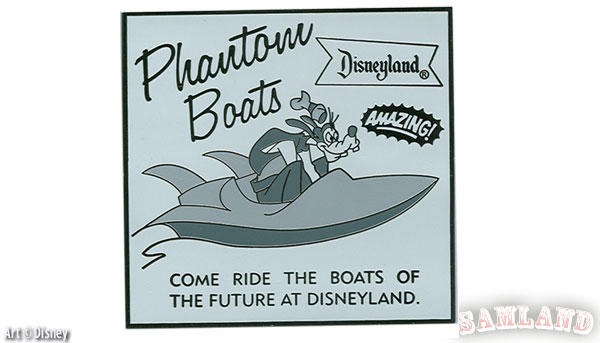
Things change. As Disney Legend Bob Gurr said, “In those days, everybody had a hovercraft project. It was a neat idea…a ‘big buzz’ at the time, and a lot of people were working on it simultaneously.” Even the folks at WED had been talking about a flying saucer ride. One day, a German salesman visited WED and he brought a small propeller-powered hovercraft. Walt asked Gurr to check it out. “I tried it out, but I could see nothing but danger in it,” said Gurr.
Arrow Development, an amusement park ride manufacturer, was also looking at a hovercraft. Gurr noticed that “Arrow’s concept of moving the motive force from out of the vehicles to under the floor was a very novel idea.” Their system worked like a giant air hockey table
Building on that concept, Imagineer Roger Broggie said, “We had figured that we could move a two-thousand pound payload if we had an air jet below with valves that allow air to come up through holes in the floor.” It just so happened that a bunch of surplus actuators from the second stage of a Jupiter missile came on to the market. Broggie said, “We bought them and put them to use.” When the actuators were installed, they almost immediately failed and Disney sent them back. “They wanted to know what we had done to make them wear out like this,” Broggie said. “We estimated the actuators had cycled more than seven million times. They said that their test program had required that the actuators were actually used for five seconds on the second stage of the Jupiter missile for pitch control, then their purpose was fulfilled. They said that they’d over designed it by seven times!”
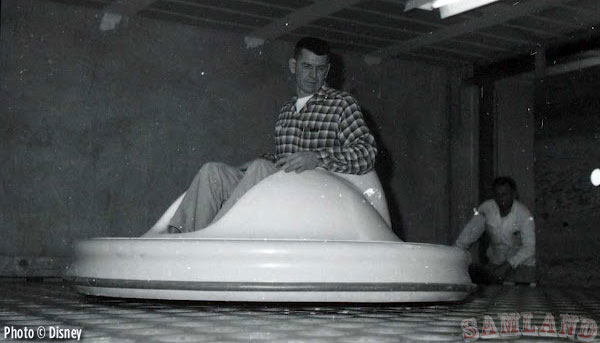
Walt told master builder Joe Fowler to work with Arrow to develop a prototype at their Northern California shop. Walt took a special interest in this project and went up to the shop for a test ride. Gurr said, “He’s extremely interested in how this thing is going to work. He’s Walt Disney, and he’s seeing this test device, and he’s trying to visualize what the attraction will be like, and what public’s response might be. This happened all the time.” The prototype worked and the attraction was put into hyperdrive.
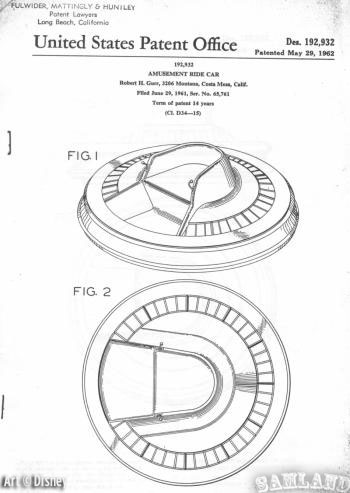
Bob Gurr designed the sleek flying saucers and also received a patent for his efforts. In his fun new book Design: Just for Fun, he said, “I was now recognized by the United States government as a ‘flying saucer inventor,’ a title which placed me in good company with all the other flying saucer crackpots of the time.” Sixty-four single seat saucers that would float on a bed of air were put into production.
To power that bed of air, four giant blowers were mounted below the ground to maintain the air pressure in a complex 16,000 square foot network of air ducts with holes and valves. As a flying saucer passed over a valve, the air pressure would become imbalanced and the valve would open. This provided the lift. The constant air pressure would quickly close the valve once the saucer has moved on.
Pilots could steer their saucers by leaning one way or another. Lean forward and air would escape out the back of the saucers skirt pushing you forward. Lean back and you move back. Move either way too much and you stall. Longtime Disneyland Cast Member Ron Dominguez said, “A heavy person would sit there like a slug trying to move around on the table and a kid would bounce. The concept was all right, but that was a tough attraction to operate.”
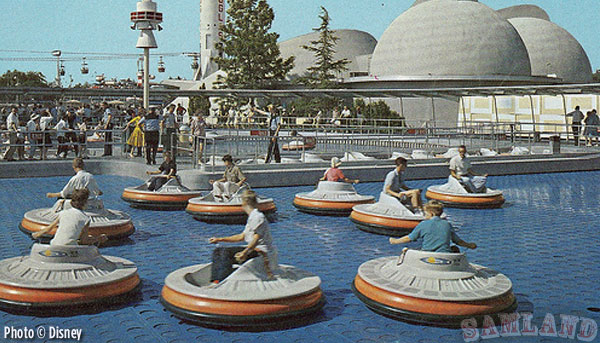
Imagineer Bill Martin came up with the innovative loading/unloading system. Martin said, “The shape of that ride, and the way the boom worked, was from an idea I picked up at Riverside Park in Chicago.” The ride in Chicago was a bunch of little boats circulating in a rectangular shaped pond. “When the ride time was up this bridge would wipe these people off the pond, and let the other guys free to play on the pond while they loaded over there for the next time,” Martin recalled. His idea to improve upon this system was a “circular area which would load on both sides and with two arms, or booms.” Martin received a patent for his design. He noted, “They were supposed to pay me a buck, but never did.”
The flying saucers were placed on an oval arena that was separated into two halves by the loading platform. Moveable piers unfolded from the loading platform cutting the arena into quarter sections. As the piers moved, they swept sixteen of the saucers tightly against the loading platform. While this was happening, sixteen other pilots would be struggling with their vehicles out on their half of the arena. Each side was operated independently and this system allowed for thirty-two saucers loading while thirty-two saucers were operating at any one time.
During installation and testing, the attraction was plagued with problems. “Bob Gurr’s hollow saucer really worked well up at Arrow Development when they built the prototype, but that’s because the plenum was only four feet deep,” according to Bill Martin. “The one we built at the Park was nine feet deep and that was our mistake. Since air squashes and compresses, there was too much lag…we lost our deck all the time, and it took awhile to build up the pressure again.”
The new attraction opened on August 8, 1961. Due to the mechanical issues, it was the first Disneyland attraction that failed to open on schedule. The attraction was very popular with the public but plagued by maintenance issues. Gurr said, “The pressure under the floor would drop so low that all the “Morgan valves” would open at once, releasing the air beneath. This caused a window rattling sonic boom and the Saucers would drop to the ground.” He blamed it on “undamped divergent oscillation.” Due to the operational issues, the saucers closed on September 5, 1966.
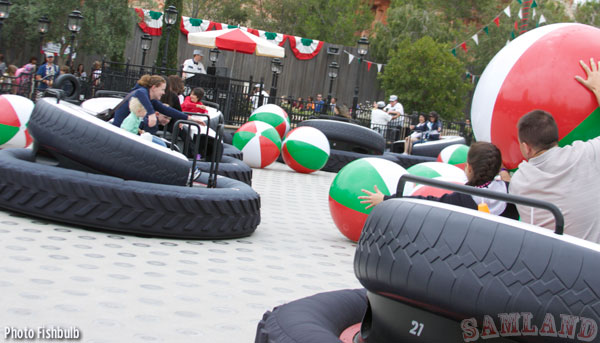 Luigi’s Flying Tires today
Luigi’s Flying Tires today
Gurr said, “In hindsight, had it gone through several levels of production, it could have become successful. What was needed were electronic controls and high speed damper doors so that the flow of air in the plenum could have been kept uniform despite the interaction of the bouncing saucers above, and the pressure changes would not have effected the valves.” Like so many of Walt’s dreams, the technology was not up to the vision. Gurr noted, “This is always the problem with mechanically operated devices versus those that are electronically operated with sensors that feed a processor which makes all the decisions. With a few electronic feedbacks, and a control system which could have worked the doors quickly, the ride could have continued. But this was all done before computerization. With sensor-pressure data, high-speed action on the damper doors and a program written for damping and smoothing…the whole thing could probably be operated with one PC today.”
Did you get to ride the Flying Saucers? Are we seeing history repeat with Luigi’s Flying Tires in California Adventure’s Cars Land?


Meet Imagineering Legend Bob Gurr – Book Signing and Lunch – June 30, 2012
Bob Gurr is a true Disney and theme park design legend. He’s also a fantastic story teller and all around nice guy (as you read from Garner above). And lucky for us, there is a limited opportunity for you to grab a signed and numbered copy of his new book and join him for lunch at the Anabella Hotel (just behind DCA and next to the Anaheim Convention Center) on June 30th. The Collector’s Edition of his new book Design: Just for Fun has already sold out, but we’ve got the last 100 copies saved for our readers. Don’t miss out on this unique opportunity to spend time with one of the true greats of Disney Design. Sign up for the Bob Gurr Luncheon and Book Signing Today!

